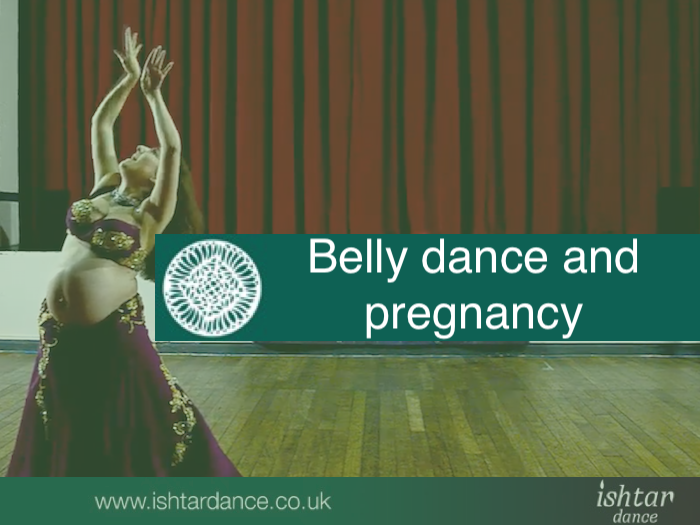Belly dance and pregnancy
By Ishtar Dance on Monday, April, 9th, 2018 in Belly Dance & Pregnancy, Dance Inspiration, Your Dance Body No Comments

Although there currently isn’t any scientific evidence to support the fact that belly dancing can have a positive impact on pregnancy and birth, there is plenty to suggest that the two compliment one another perfectly.
Having danced through 9 months of carrying my son, teaching several pregnant students and collaborating with my local Children’s Centre to run classes for expecting and new mums, I have gained a lot of knowledge about dancing whilst pregnant.
In Western medicine movements such as hip circles and undulations are all recommend by physiotherapists to help alleviate the pain during labor, which is probably why so many dancers worry whether it is safe for them to continue dancing once pregnant. However, if you’re already dancing and are experiencing a health pregnancy, then you’re most likely to be fine to continue. But it’s never advised to take up any new form of exercise, and if you’ve previously experienced complications then you should also be cautious.
Pregnancies really can’t, and shouldn’t, be generalised, as they are as different as the women having them. So do have a chat with your GP or Midwife first so you can continue with peace of mind.
Thousands of women have danced through their pregnancies. It is not an illness, but there are few key things that are essential to keep in mind if you are a pregnant dancer, or teaching one.
Relaxin = lose ligaments
The hormone relaxin affects many things in your body during pregnancy, but one of its key jobs is, as it’s name may suggest, to loosen your pelvic ligaments and cervix, so you can deliver your baby. Relaxin is already in your body and its levels are linked to your menstruation cycle. However, during pregnancy the levels are much higher, especially in the first trimester, where its main job is to inhibit contractions in the uterus wall, to prevent premature childbirth. But it also helps with the increased demand for oxygen and nutrients for the foetus, by relaxing the blood vessels to increase blood flow to the placenta.
Relaxin alters the properties of cartilage and tendons, and this can destabilise joints, which can cause injuries. Think of it as your bones being held together with flimsy elastic bands instead of strong industrial size ones! You should therefore be extra careful of over stretching, twisting or doing any other move that may put your unsteady joints at risk. Relaxin stays in the body up to five months after breastfeeding finishes. This means that you pelvis and joints will remain less stabile until then.
However, if you’re already dancing, and have done so for a long while, you should already be aware of your own limitations, and a bit of common sense is therefore likely to keep you safe. When I told a hospital physiotherapist that I was still dancing (then 6 months pregnant), she encouraged me to continue doing so, but also told me to stop doing any stretches. I found that quite odd and did some additional research, which confirmed that you can still go about you ‘daily activities’ despite being pregnant or post-natal. However, being super flexible and having considerably looser joints, does mean you have to be extra careful not least if performing.
I did my last public performance 8 months pregnant, and I still remember how hard it was to hold myself back, and how worried I was afterwards, whether I had injured my knee by adding a bit too much power to my moves. It’s very easy to get carried away once the music starts! You can see the performance here.
So please do take extra care when dancing and don’t over stretch. Avoid any sharp, sudden or quick movements that you can’t fully control in your current pregnant state. Your point of gravity shifts all the time as your baby grows, so what was possible even a week ago, may no longer be a safe option. Moving more gentle and aiming to maintain fitness, instead of developing it, is a good way to keep dancing safely throughout pregnancy.
Overheating
Being pregnant means you’re likely to be hotter than normal, but it’s also very important not to overheat, especially in the first trimester, where it can cause birth defects and miscarriage. In late pregnancy, overheating becomes more of a problem for the mother, who can easily dehydrate.
Unless you are dancing in a very hot studio or working on a very vigorous routine, belly dancing isn’t likely to make you overheat. According to kidshealth.org it is considered ‘overheating’ if your body temperature goes above 102°F (38.9°C) for more than 10 minutes.
However, I always advice my pregnant students to take extra care not to get too hot at any time during their pregnancy, whether dancing or not.
When not to dance
Around 15-20% of pregnant women are thought to miscarry before 12 weeks. The body is designed to reject the pregnancy if it is not healthy, but some women may also suffer miscarriages for other reasons.
That is why I always advice women to consult their doctor first, especially if they’ve had a complications before. It is essential to listen very carefully to your body when pregnant and take it ultra slow no matter what exercise you do, especially at the beginning.
Anyone suffering complications in their pregnancy, such as Pre-eclampsia, Placenta Previa or a history of premature labour should always speak to their GP or midwife before attending class.
Generally, keeping moving and especially continuing to belly dance if you already do so, is one of the best things you can do for your body during pregnancy, as it will keep you fit and strong. Most dancers that I know, have never felt as good about their bodies, as when they were dancing with their bump. The problems normally start when women stop moving, as their belly grows. It does of course depend on whether it’s a ‘normal’ pregnancy, or not, and things can also change very suddenly.
I always ask my students to listen to their body, and know their own limitations. It will vary from week to week, depending on health, tiredness, stress levels etc. and during pregnancy this becomes even more paramount. As the stomach grown, the abdominals are stretched (and may even separate), and along with the added body weight and altered point of gravity, this means moving at a slower pace than normal is vital. Turns and spins should also be avoided, due to the risk of falling, but also because you’re more likely to loose your balance and get dizzy when pregnant.
So if you are pregnant or have students who are, ensure to listen extra well to that ever-changing body, take it easier than normal, but do also enjoy dancing with your bump. My baby certainly loved dancing, and would only start kicking when I stopped.
There’s also something special about dancing in pregnancy. I felt really light and lifted, even at the end of my pregnancy, when dancing. Physically I believe this was because I maintained good and safe posture, and mentally because it allowed me to feel and move myself, as well as my baby, in a graceful way, despite looking and feeling extremely heavy.
I hope you found this article useful and would be delighted if you shared your thoughts and any experiences that you may have on this topic, in the comments below.
Happy and safe dancing – always 🙂
Dorte
Did you miss my last post? Read it here: Why repetition is essential to dancing your best

Leave a Reply